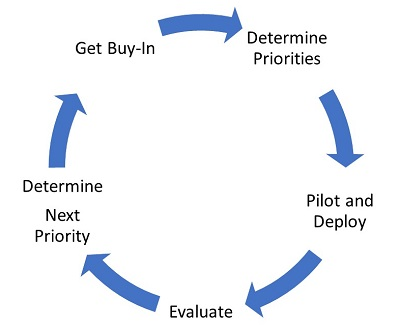ATD Blog
Operationalizing Training in Manufacturing: Part 2
Fri Feb 14 2020

In Pay No Attention to the Man Behind the Curtain, we talked about the need to do more with less in this ever-changing volatile environment. That post set the tone for helping your organization achieve a foundation around training and development and ensuring you, as a practitioner, have a seat at the decision-making table. The following model was created to help depict a fast way to roll out training initiatives for your organization.

Getting buy-in is the most critical phase. And when resources are an issue, it’s even more critical. When every dime is counted and every additional head count is managed (as is true in a lean environment), you have to make sure you have the decision-makers on your side and doing that means you have already established a clear plan for “what’s in it for those decision-makers.” Today we will cover the remaining phases: determine priorities, pilot and deploy, evaluate, and determine next priority.
Determining Priorities
So, you’ve sold your team the dream for why the need of a holistic, systematic training program in manufacturing is needed and they are ready to jump. Awesome! The first of many major hurdles has been conquered. The next step is determining what is a priority for you.
When you are establishing or developing a training program, your site is most likely in a static or reactive phase. (Being in a reactive phase means that there is no or minimal vision and that resources are inadequate or barely cutting it and content is nonexistent or extremely scattered.)
Step 1. Locate the following information:
a. vision and strategy
b. your site’s key performance indicators.
Look for poor-performing indicators. At this point, you are looking for quick wins. What areas is your company suffering in based on data? Are any of these in part to human behavior? Can any of these indicators be influenced by development or training? Start here.
A good example of an indicator that you may be able to influence that is tracked due to government requirements, no matter where you work, is safety. Have there been any incidents recently that are trending and seemingly mindless? Mistakes like these usually can be influenced by refreshed and an increased rigor around safety training.
Don’t try to do too much at once—gather your list of areas that you can impact and drill down a little further. After looking at your list of priorities, decide:
Who is the biggest customer? This could be an issue that affects the entire facility, or an issue that influences the largest department, or a department with the most money. (We need wins and to team up with those that can make that happen.) When you identify your biggest customer, sit down with them and complete a training analysis or a general interview to understand their pain points and use creativity for how training and can provide a solution.
Once you have narrowed who you’re going to help and how you are going to help, you need to pilot and deploy.
Pilot and Deploy
Getting to this step is a major accomplishment, so pat yourself on the back. You met with the initial stakeholders to determine priorities, but the last thing you want to do is go implement a new change or process to people without letting them know something new is coming. A brief meeting with the second and first levels of leadership to get their input on what’s coming will pay dividends toward the success of your program.
After communicating to the stakeholders and the second- and first level-leaders, it’s time to pilot. We don’t want to roll the program out to the entire group without ironing unseen kinks in the program. The best way to do that is to test the program on a smaller group. It is in this phase that you need to get, keep, and build engagement. During the pilot group, it’s best to get as much communication about the program as you can, and if the audience mentions any outstanding concerns, make sure you close those concerns before you deploy to the larger audience. This smaller pilot group is going to be a part of your success champions, and the goal is to get this group to be your advocate to the larger deployment audience.
Once you have tested your program on your pilot group, it’s time to deploy. Make sure you’re ready; the biggest item here is the metric are we reporting on.
Evaluate
Did you do what you said you were going to do? How can you know? Get intricately involved in the metrics you used to define your priorities. It’s time to watch the trends. Do you notice that safety incidents are trending down or increasing? Whatever happens, react. This may mean you need to adjust the program, or it may speak to the success of your overall program. Did you affect the metrics you set to achieve? Write it down. And then do yourself a favor for the next step and send out a debrief to the participants and stakeholders. This will only create a great buzz to help support your next activity. Because the initial program is really a chance for trial and error, it’s here you want to know what worked and what didn’t. Highlight those challenges build a plan to mitigate future risks based off lessons learned and highlight best practices so you can create repeatable processes.
Determine Next Priority
If creating a holistic systematic training program in manufacturing, the only way to do that is to go back to the first step. Determine your next priority, get buy-in, align to strategy, and rock!
This may seem as if it’s oversimplifying the issue, but the foundation is clear—get buy-in, determine priorities, pilot and deploy, evaluate, and determine next priority. What’s more, always align to strategy.
You've Reached ATD Member-only Content
Become an ATD member to continue
Already a member?Sign In
